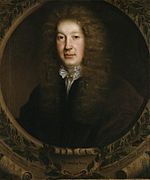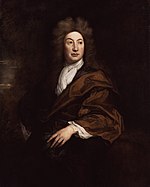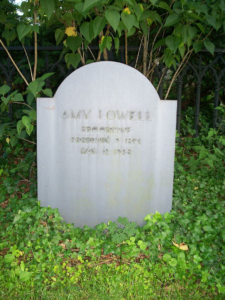| John Dryden | |
|---|---|
 |
|
On this day in 1700, poet, literary critic, translator, and playwright John Dryden died in London at the age of 68. Born on 19 August [O.S. 9 August] 1631 in Aldwincle, Thrapston, Northamptonshire, England. Dryden was made England’s first Poet Laureate in 1668. His influenced the literary life of Restoration England to such a point that the period came to be known in literary circles as the Age of Dryden. Walter Scott called him “Glorious John”.
Dryden is believed to be the first person to posit that English sentences should not end in prepositions because Latin sentences cannot end in prepositions. Dryden created the proscription against preposition stranding in 1672 when he objected to Ben Jonson‘s 1611 phrase, “the bodies that those souls were frighted from”, though he did not provide the rationale for his preference. Dryden often translated his writing into Latin, to check whether his writing was concise and elegant, Latin being considered an elegant and long-lived language with which to compare; then Dryden translated his writing back to English according to Latin-grammar usage. As Latin does not have sentences ending in prepositions, Dryden may have applied Latin grammar to English, thus forming the rule of no sentence-ending prepositions, subsequently adopted by other writers.
The phrase “blaze of glory” is believed to have originated in Dryden’s 1686 poem The Hind and the Panther, referring to the throne of God as a “blaze of glory that forbids the sight”.
On 1 December 1663 Dryden married Lady Elizabeth Howard (died 1714). The marriage was at St. Swithin’s, London, and the consent of the parents is noted on the licence, though Lady Elizabeth was then about twenty-five. She was the object of some scandals, well or ill founded; it was said that Dryden had been bullied into the marriage by her brothers. A small estate in Wiltshire was settled upon them by her father. The lady’s intellect and temper were apparently not good; her husband was treated as an inferior by those of her social status. Lady Elizabeth Dryden survived her husband, but went insane soon after his death. Though some have historically claimed to be from the lineage of John Dryden, his three children had no children themselves.
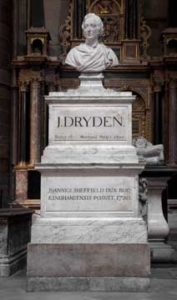 The Final Footprint
The Final Footprint
Dryden was initially buried in St. Anne’s cemetery in Soho, before being exhumed and reburied in Westminster Abbey ten days later. He was the subject of poetic eulogies, such as Luctus Brittannici: or the Tears of the British Muses; for the Death of John Dryden, Esq. (London, 1700), and The Nine Muses. A Royal Society of Arts blue plaque commemorates Dryden at 43 Gerrard Street in London’s Chinatown. Other notable Final Footprints at Westminster include; Robert Browning, Lord Byron, Charles II, Geoffrey Chaucer, Oliver Cromwell, Charles Darwin, Charles Dickens, Edward III, Edward VI, Edward The Confessor, Elizabeth I, George II, George Frideric Handel, Stephen Hawking, Henry III, Henry V, Henry VII, James I (James VI of Scotland), Samuel Johnson, Ben Jonson, Rudyard Kipling, Henry Wadsworth Longfellow, Mary I, Mary II, Mary Queen of Scots, John Milton, Isaac Newton, Laurence Olivier, Henry Purcell, Thomas Shadwell, Edmund Spenser, Lord Alfred Tennyson, Dylan Thomas, and William III

Dryden near end of his life
“A man is to be cheated into passion, but to be reasoned into truth.”
Lines 789–795 of Book 2 when Aeneas sees and receives a message from the ghost of his wife, Creusa.
iamque vale et nati serva communis amorem.’
haec ubi dicta dedit, lacrimantem et multa volentem
dicere deseruit, tenuisque recessit in auras.
ter conatus ibi collo dare bracchia circum;
ter frustra comprensa manus effugit imago,
par levibus ventis volucrique simillima somno.
sic demum socios consumpta nocte reviso
Dryden translates it like this:
I trust our common issue to your care.’
She said, and gliding pass’d unseen in air.
I strove to speak: but horror tied my tongue;
And thrice about her neck my arms I flung,
And, thrice deceiv’d, on vain embraces hung.
Light as an empty dream at break of day,
Or as a blast of wind, she rush’d away.
Thus having pass’d the night in fruitless pain,
I to my longing friends return again
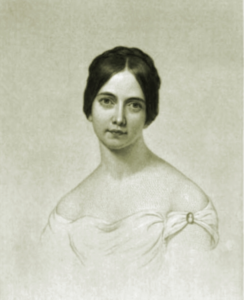 On this day in 1850, poet Frances Sargent Osgood died of tuberculosis at her home in New York City at the age of 38. Born Frances Sargent Locke on June 18, 1811 in Boston. She was one of the most popular women writers during her time. Nicknamed “Fanny”, she was also famous for her exchange of romantic poems with Edgar Allan Poe. In 1834, while composing poems inspired by paintings, Frances met Samuel Stillman Osgood, a young portrait artist at the Boston Athenaeum. He asked her to sit for a portrait. They were engaged before the portrait was finished and married on October 7, 1835.
On this day in 1850, poet Frances Sargent Osgood died of tuberculosis at her home in New York City at the age of 38. Born Frances Sargent Locke on June 18, 1811 in Boston. She was one of the most popular women writers during her time. Nicknamed “Fanny”, she was also famous for her exchange of romantic poems with Edgar Allan Poe. In 1834, while composing poems inspired by paintings, Frances met Samuel Stillman Osgood, a young portrait artist at the Boston Athenaeum. He asked her to sit for a portrait. They were engaged before the portrait was finished and married on October 7, 1835.
In February 1845, Poe gave a lecture in New York in which he criticized American poetry, especially that of Henry Wadsworth Longfellow. He made special mention, however, of Osgood, saying she had “a rosy future” in literature. Though she missed the lecture, she wrote to her friend, saying Poe was “called the severest critic of the day”, making his compliment that much more impressive.
It is believed Poe and Osgood first met in person when introduced by Nathaniel Parker Willis in March 1845 when Osgood had been separated from (but not divorced from) her husband. Poe’s wife, Virginia, was still alive, but in ill health. Poe may have been attracted to Osgood because they were both born in Boston and possibly due to her childlike qualities which were similar to Virginia’s. She may have already been in an early stage of tuberculosis, just like Virginia.
In 1845, Poe used his role as one-third owner of the Broadway Journal to print some of Osgood’s poems, including some flirtatious ones: “The Rivulet’s Dream” (1845), “So Let It Be. To–” (1845), “Love’s Reply” (1845), “Spring” (1845), “Slander” (1845), “Echo-Song” (1845), “To–” (1845), “A Shipwreck” (1845) and “To ‘The Lady Geraldine” (1845). Poe responded with published poems of his own, occasionally under his pseudonym of Edgar T. S. Grey. Most notable is his poem “A Valentine”. The poem is actually a riddle which conceals Osgood’s name, found by taking letter 1 from line 1, letter 2 from line 2, and so on. Despite these passionate interchanges, the relationship between Poe and Osgood is often considered purely platonic.
Virginia approved of the relationship and often invited Osgood to visit their home. Virginia believed their friendship had a “restraining” effect on her husband. Poe had given up alcohol to impress Osgood, for example. Virginia may also have been aware of her own impending death and was looking for someone who would take care of Poe. Osgood’s husband, Samuel, also did not object, apparently used to his wife’s impetuous behavior. He himself had a reputation as a philanderer.
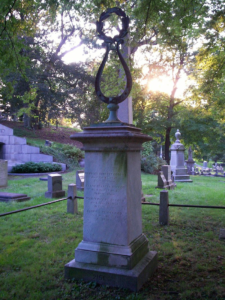 The Final Footprint
The Final Footprint
Her last word, “angel”, was written on a slate to her husband. She was buried in her parents’ lot at Mount Auburn Cemetery in Cambridge, Massachusetts. In 1851, a collection of her writings was published by her friends and titled The Memorial, Written by Friends of the Late Mrs. Frances Sargent Locke Osgood. It was reissued as Laurel Leaves in 1854. The volume was meant to raise money for her memorial headstone. However, Fanny Fern noted that, by 1854, the plot remained unmarked and criticized Samuel Osgood in her book Fern Leaves from Fanny’s Port-Folio. Samuel Osgood noted in the New York Evening Post that he had already designed a monument, inspired by her poem “The Hand That Swept the Sounding Lyre”, which was soon installed. Other notable final footprints at Mount Auburn include; Winslow Homer, Julia Ward Howe, Henry Wadsworth Longfellow, Amy Lowell (see below), and Bernard Malamud.
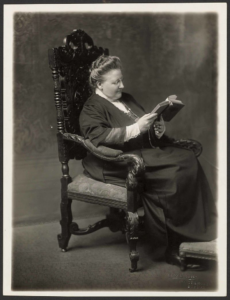 On this day in 1925, poet Amy Lowell died of a cerebral hemorrhage in Brookline, Massachusetts, at the age of 51. Born Amy Lawrence Lowell on February 9, 1874 in Brookline. Her poetry is classified as being from the imagist school. She posthumously won the Pulitzer Prize for Poetry in 1926.
On this day in 1925, poet Amy Lowell died of a cerebral hemorrhage in Brookline, Massachusetts, at the age of 51. Born Amy Lawrence Lowell on February 9, 1874 in Brookline. Her poetry is classified as being from the imagist school. She posthumously won the Pulitzer Prize for Poetry in 1926.
In 1912 she and actress Ada Dwyer Russell were reputed to be lovers. Russell is possibly the subject of Lowell’s more erotic works, most notably the love poems contained in ‘Two Speak Together’, a subsection of Pictures of the Floating World. The two women traveled to England together, where Lowell met Ezra Pound, who at once became a major influence and a major critic of her work. Pound considered Lowell’s embrace of Imagism to be a kind of hijacking of the movement. Lowell has been linked romantically to writer Mercedes de Acosta.
Lowell publicly smoked cigars, as newspapers of the day frequently mentioned. Journalist Heywood Broun in his obituary tribute to Amy wrote, “She was upon the surface of things a Lowell, a New Englander and a spinster. But inside everything was molten like the core of the earth… Given one more gram of emotion, Amy Lowell would have burst into flame and been consumed to cinders.”
The Final Footprint
Lowell is interred in Mount Auburn Cemetery in Cambridge, Massachusetts. Other notable final footprints at Mount Auburn include; Winslow Homer, Julia Ward Howe, Henry Wadsworth Longfellow, Bernard Malamud, and Frances Sargent Osgood (see above).
#RIP #OTD in 1980 singer and actress, her life story was told in her memoir and 1955 film I’ll Cry Tomorrow (portrayed by Susan Hayward, who was nominated for the Academy Award for Best Actress), Lillian Roth died at De Witt Nursing Home in Manhattan aged 69. Mount Pleasant Cemetery, Hawthorne, New York
#RIP #OTD in 1985 painter and sculptor of the Ecole de Paris, founder of the art movement art brut, Jean Debuffet died from emphysema in Paris aged 83. Cimetière de Tubersent, France
 On this day in 2000, professional racing driver, great-grandson of Lee Petty, grandson of Richard Petty, son of Kyle Petty, Adam Petty died when his Busch series car crashed during a practice run at New Hampshire Motor Speedway in Loudon, New Hampshire, at the age of 19. Born Adam Kyler Petty on 10 July 1980 and raised in High Point, North Carolina.
On this day in 2000, professional racing driver, great-grandson of Lee Petty, grandson of Richard Petty, son of Kyle Petty, Adam Petty died when his Busch series car crashed during a practice run at New Hampshire Motor Speedway in Loudon, New Hampshire, at the age of 19. Born Adam Kyler Petty on 10 July 1980 and raised in High Point, North Carolina.

President George W. Bush is joined at Adam’s Race Shop on the grounds of Victory Junction Gang Camp, Inc., in Randleman, N.C., by NASCAR drivers Kyle Petty, Richard Petty, Michael Waltrip and Jimmie Johnson
The Final Footprint – Adam was cremated and his cremains were returned to his family. In October 2000 five months after Adam’s death, his family partnered with Paul Newman and the Hole in the Wall Gang Camp to begin the Victory Junction Gang Camp, a camp for terminally and chronically ill children, in Randleman, North Carolina, as a memorial to Adam. The camp has received support from many NASCAR drivers, teams, and sponsors, including Cup Series sponsor Sprint, which has placed a replica of Adam’s 1998 car in the camp. The Victory Junction Gang camp began operation in 2004, and is an official charity of NASCAR. I have been fortunate enough to spend a weekend at Victory Junction. Enough good things cannot be said about this wonderful place and what it means to the kids and families who visit. Thank you to the Petty family and all those involved in creating and maintaining VJ. More importantly, thank you Adam.
| Perry Como | |
|---|---|
 on the Perry Como Show set, c. 1956 |
|
On this day in 2001, singer and television personality, Mr. C, Perry Como died at his home in Jupiter Inlet Colony, Florida at the age of 88. Born Pierino Ronald Como on May 18, 1912 in Canonsburg, Pennsylvania. During a career spanning more than half a century he recorded exclusively for the RCA Victor label after signing with it in 1943. He pioneered a weekly musical variety television show, which set the standards for the genre and proved to be one of the most successful in television history. Como’s appeal spanned generations and he was widely respected for both his professional standards and the conduct in his personal life. In the official RCA Records Billboard magazine memorial, his life was summed up in these few words: “50 years of music and a life well lived. An example to all.
Como received five Emmys from 1955 to 1959, a Christopher Award (1956) and shared a Peabody Award with good friend Jackie Gleason in 1956. He received a Kennedy Center Honor in 1987. Posthumously, Como received the Grammy Lifetime Achievement Award in 2002. Como has the distinction of having three stars on the Hollywood Walk of Fame for his work in radio, television, and music.
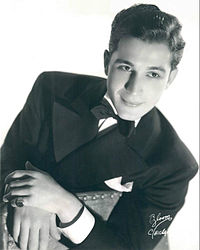
in 1939, when he was with the Ted Weems Orchestra.

publicity photo
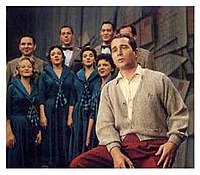
with the Ray Charles Singers on the set of The Perry Como Show during “Sing To Me, Mr, C.” segment, c. 1950s. Como’s “sweater era”.
In 1929, the 17-year-old Como met Roselle Belline at a picnic on Chartiers Creek that attracted many young people from the Canonsburg area. Como, who attended the cookout with another girl, did not spot Roselle until everyone was around the campfire singing and the gathering was coming to a close. When it came Como’s turn to sing, he chose “More Than You Know”, with his eyes on Roselle for the entire song. The teenage sweethearts were married July 31, 1933. In 1958, the Comos celebrated their silver wedding anniversary with a family trip to Italy.
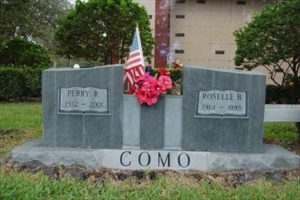 The Final Footprint
The Final Footprint
His funeral Mass took place at St. Edward’s Catholic Church in Palm Beach, Florida. Como and his wife, Roselle are interred at Riverside Memorial Park, Tequesta (Palm Beach County), Florida.
#RIP #OTD in 2008 painter and graphic artist whose early works anticipated the Pop art movement (Combines, Canyon, Monogram), Robert Rauschenberg died of heart failure on Captiva Island, Florida, aged 82
#RIP #OTD in 2014, artist (album covers; Danzig III: How the Gods Kill, Deborah Harry’s KooKoo), film special effects designer (Alien), H. R. Giger died in Zürich from injuries from a fall, aged 74. Cimetière Gruyeres, Gruyeres, Switzerland
Have you planned yours yet?
Follow TFF on twitter @RIPTFF

